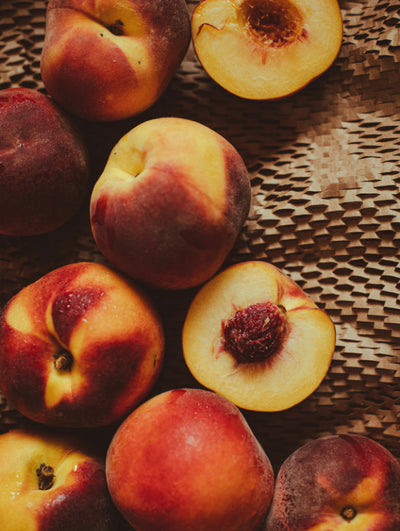Endocrine disrupting chemicals (EDC) are everywhere, and even for those mindful of health, striving for 'toxin-free living' is virtually impossible. Beyond their environmental impacts, these toxins contribute to adverse health effects, such as, hormonal imbalances, reproductive hinderances and even links to certain cancers. (1) But, whilst the presence of these toxins in our environment is an uncomfortable truth we need to live with, the good news is that we can significantly reduce our exposure once we know what to look for. And, because a lot of these chemicals last for days or weeks in the body, and not years, eliminating them from our repertoire can have almost an immediate effect.
These environmental toxins lurk in our food, drinking water, cosmetics, fragrances, household cleaners and clothing, posing a dual threat to both the environment and our wellbeing. So, what are they and how can we minimise our exposure?
Perchloroethylene (PCE)
Perchloroethylene, commonly known as PCE or PERC, is a widely used chlorinated solvent in dry cleaning, clothing production, and various household items like glue and wood cleaners. (2) Exposure to PCE can happen through drinking water, inhalation of PCE vapours in the air, or direct skin contact while handling products. (2) Studies indicate that prenatal exposure to PCE-contaminated drinking water is linked to an increased risk of pregnancy complications, including stillbirths and birth defects. (3) Additionally, PCE can impact fertility and prolong time to conception. (3) These adverse effects, coupled with potential harm to the liver and kidneys, highlight the associated health risks.
Minimise exposure: When selecting household products, check ingredient lists for PCE and choose natural formulas where possible. (4) Common household products that use PCE include stain removers, fabric softeners, and fragranced cleaning products. Ensure adequate ventilation by opening windows and doors when handling dry-cleaned clothes and consider switching to PCE free dry cleaners (often called ‘green’ dry cleaners) instead.
Bisphenol A (BPA)
Bisphenol A (BPA), a synthetic compound present in various plastic products like food containers, dental fillings, and resins, can migrate into food, with 90% of exposure occurring through the diet. (5) Research has shown that bisphenols can imitate estrogen, contributing to health issues like uterine cancer, early puberty, menstrual irregularities, and an elevated risk of endometriosis. (5) In addition, elevated BPA levels (ranging from 10 to 400 mg/kg) have been associated with altered blood sugar regulation. (5) The extensive use of plastic raises concerns about the broad and far-reaching consequences of BPAs.
HOW TO LIMIT EXPOSURE: To reduce exposure, consider limiting plastic use by switching to reusable stainless-steel alternatives instead of plastic bottles. Use glass containers for leftovers in place of plastic Tupperware. Packaged foods are some of the worst culprits, which gives us another strong reason to move away from ultra processed foods towards whole, natural foods. Try to cook at home more often to reduce reliance on packaged foods and take your own food when flying or on the go to help minimise exposure. Where possible, opt for fresh, unpackaged foods instead of canned ones, as cans contain BPA to enhance their durability, and look for food brands that opt for BPA free packaging.
Phthalates
Phthalates, also known as plasticisers, are additives in plastic that enhance its flexibility by providing a softening effect. Found in various products that encounter plastics during packaging or delivery processes, such as shampoos, fragranced cosmetics, nail polish, hair sprays and soaps, these compounds can have widespread exposure. (6) Notably, foods high in fat, like dairy and meat, are more prone to absorbing phthalates from their packaging, highlighting a potential route for dietary intake of these substances. (6) Children, especially during their early years, are more susceptible to the impacts of phthalate exposure compared to adults; exposure can affect their development, including height, weight risk of obesity, and thyroid function. (6) In adults, Phthalates are also linked to breast cancer, reduced fertility, asthma and obesity.
HOW TO LIMIT EXPOSURE: Take practical steps, like avoiding the heating of food in plastic containers, steering clear of fragrances that may contain phthalates, and carefully reading labels on personal care products; you may need to contact the brand to confirm, as phthalates have various names. Opt for wooden utensils and packaging that are free from phthalates. (6) Protect children by avoiding older plastic toys and teething rings and always read the labels, some common forms of phthalates on labels may look like this: DBP (dibutyl phthalate) DNOP (di-n-octyl phthalate) DiNP (diisononyl phthalate) DEP (diethyl phthalate) BBzP (benzyl butyl phthalate) DEHP (di 2-ethylhexl phthalate) DiDP (diisodecyl phthalate) DnHP (di-n-hexyl phthalate)
Glyphosate
Glyphosate, the active ingredient in many herbicides, is one of the most widely used chemicals in agriculture. (7) While it effectively kills weeds, its use has led to concerns about its impact. Residues of glyphosate can infiltrate soil, crops, and water sources, triggering unintended health effects. Glyphosate disrupts the microbiome, and studies have associated glyphosate exposure with heightened inflammation, increased anxiety levels, and behaviours resembling depression. (7) Beyond mood disorders, glyphosate is implicated in various conditions including attention deficit hyperactivity disorder, cancer, autism, and neurodegenerative diseases like Alzheimer's and Parkinson's. (7) Its use has been prevalent in the US for decades, and unfortunately, is on the rise in the UK and throughout the EU.
HOW TO LIMIT EXPOSURE: Prioritise buying organic food, particularly for crops that often undergo heavy spraying, such as berries, wheat, grain products, oats, leafy greens, celery, and potatoes.
What else you can do:
Whilst reducing exposure is important, optimising our own detoxification pathways also plays a critical role. Supporting the liver – our main organ of detoxification – and keeping the bowel healthy are key. Here’s what you can do:
Recognising and tackling the influence of environmental toxins is something that can help us lead healthier lives. If it feels overwhelming, just start slowly; check labels, be mindful of food packaging, and slowly transition to cleaner, more sustainable alternatives.
References:
-
Ceballos DM, Fellows KM, Evans AE, Janulewicz PA, Lee EG, Whittaker SG. Perchloroethylene and Dry Cleaning: It's Time to Move the Industry to Safer Alternatives. Front Public Health. 2021 Mar 5;9:638082.
-
Guyton KZ, Hogan KA, Scott CS, Cooper GS, Bale AS, Kopylev L, Barone S, Makris SL, Glenn B, Subramaniam RP, Gwinn MR, Dzubow RC, Chiu WA. Human health effects of tetrachloroethylene: key findings and scientific issues. Environ Health Perspect. 2014 Apr;122(4):325-34.
-
Aschengrau A , Winter MR , Gallagher LG , Vieira VM , Butler LJ , Fabian MP , Carwile JL , Wesselink AK , Mahalingaiah S , Janulewicz PA , Weinberg JM , Webster TF , Ozonoff DM . Reproductive and developmental health effects of prenatal exposure to tetrachloroethylene-contaminated drinking water. Environ Sci Process Impacts. 2020 Mar 1;22(3):555-566.
-
Office of Land Quality – Science Services Branch. Tetrachloroethene (PCE), INDIANA DEPARTMENT OF ENVIRONMENTAL MANAGEMENT, IDEM FACT SHEET; 317-232-8603
-
Ohore OE, Zhang S. Endocrine disrupting effects of bisphenol A exposure and recent advances on its removal by water treatment systems. A review, Scientific African. 2019; 5;2468-2276
-
Wang Y, Qian H. Phthalates and Their Impacts on Human Health. Healthcare (Basel). 2021. 18;9(5):603.
-
Costas-Ferreira C, Durán R, Faro LRF. Toxic Effects of Glyphosate on the Nervous System: A Systematic Review. Int J Mol Sci. 2022. 21;23(9):4605.



















































